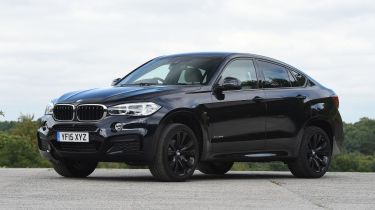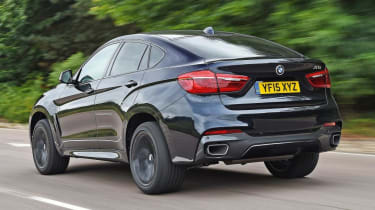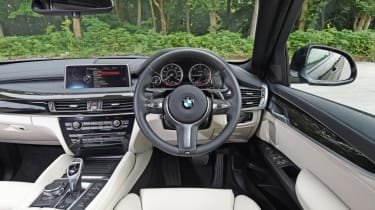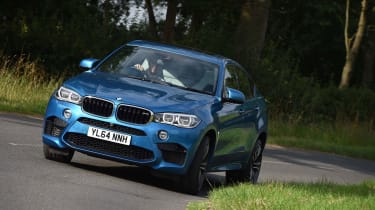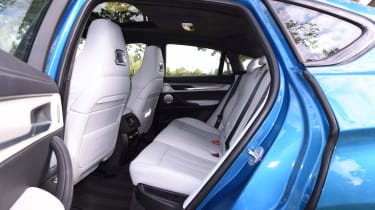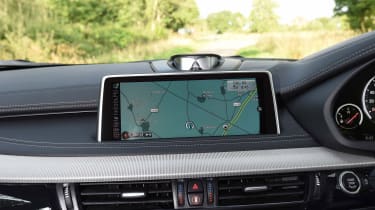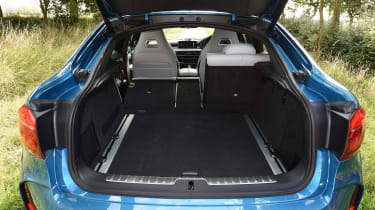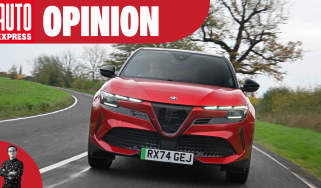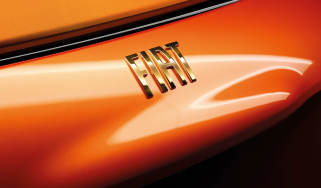Used BMW X6 (Mk2, 2014-2019) buyer’s guide: style over substance, but still great to drive
A full used buyer’s guide on the BMW X6 covering the Mk2 that was on sale between 2014 and 2019
Verdict
There’s a noticeable element of style over substance with the X6, but if ultimate carrying capacity isn’t your highest priority, then this is a car that’s surprisingly easy to recommend. That’s because, as you would expect of anything wearing that hallowed BMW badge, the X6 is genuinely enjoyable to drive, superbly put together and features all of the latest safety and luxury tech you could possibly ask for. It’s also supremely qualified for towing, so if you’ve got a large caravan, few vehicles will pull with such ease. Most of the cars for sale are still under warranty but, so far at least, reliability seems to be another of the X6’s trump cards, making this a relatively painless car to own.
BMW introduced the original X6 to some sharp intakes of breath in 2008. Lots of people couldn’t understand the brand’s rationale for building a huge SUV (or SAC – Sports Activity Coupé in BMW parlance) that was less useful than the X5 on which it was based and, to many eyes, less handsome.
But these drawbacks didn’t stop the X6 selling like hot cakes, so in the end it wasn’t a big shock when, in 2015, a second take on the formula was launched. With more efficient engines and more hi-tech kit, plus extra interior and boot space, the X6 Mk2 has, unsurprisingly, proven another success.
History
The second-generation BMW X6 went on sale in the UK in December 2014, priced from £51,150 for the 254bhp xDrive30d SE. Sitting above this was the £63,065, 444bhp xDrive50i, with the 376bhp M50d topping the range, at £66,920. By autumn 2015 there was also a 309bhp xDrive40d option.
In the meantime, in April 2015, the monstrous X6 M hit dealers; while it’s not a full-blown M car, with 567bhp on tap and a sub-five-second 0-62mph time, this has a turn of speed that belies its size and weight.
Used - available now

2023 VAUXHALL
COMBO CARGO
2,484 milesAutomaticElectric
Cash £11,995
2022 VAUXHALL
VIVARO
33,103 milesManualDiesel1.5L
Cash £13,495
2022 VAUXHALL
VIVARO
16,142 milesAutomaticElectric
Cash £14,995
2020 Volkswagen
Tiguan
37,401 milesAutomaticDiesel2.0L
Cash £22,800As standard all X6s came with an eight-speed automatic transmission; there’s no manual option. Buyers could choose Pure Extravagance packages for the interior (it brought two-tone leather with contrasting stitching) and exterior (alloy and gloss black highlights), plus soft-close doors, an electric glass sunroof and upgraded entertainment.
Which one should I buy?
No X6 is cheap to buy or run, but the petrol-engined editions are especially expensive to own, which is why most of the X6s for sale are diesels. The 30d isn’t slow by any means, but a 40d feels noticeably more rapid and you won’t pay a big premium to upgrade.
At launch there was an SE trim available for entry-level models, but this was soon discontinued to leave only M Sport on offer. SE editions come with leather trim, gearshift paddles, satellite navigation via a 10.2-inch display, parking sensors front and rear, xenon headlights, electrically adjusted heated front seats, plus a full suite of driver assistance systems. M Sport spec adds adaptive suspension, adaptive cruise control, sports seats and sportier exterior design details.
Alternatives to the BMW X6
The X6 had only one true rival for a long time, because until the likes of the Audi Q8 and Lamborghini Urus arrived, Mercedes’ GLE Coupé was the only other full-sized coupé-SUV on the market.
However, the Range Rover Sport, Maserati Levante and Porsche Cayenne can give the BMW a run for its money when it comes to luxury, performance, image and build quality. The Audi Q7 is worthy of consideration; as a seven-seater this puts an emphasis on usability, although it’s also fast, well equipped and luxurious.
If you like the idea of an X6 but it just seems too big, unwieldy and costly, a BMW X4 might suit better; it’s a shrunken X6, so you’ll pay less to buy and run one.
What to look for
Towing
The X6 is ideal for towing. Not only can it pull 3.5 tonnes, but trailer stability control also comes fitted as a standard feature.
Names
Know what you’re buying; the first-generation X6 was codenamed E71 by BMW, whereas its successor was referred to as F16.
Xenons
All models come with an excellent set of xenon headlights, but the adaptive LED system is an especially impressive set-up.
Head-up display
Another worthwhile and sought-after option is the head-up display, which shows five pieces of information to the driver.
Interior
Shared with the X5, the X6’s interior is swathed in premium materials and well stocked with the latest kit. There’s lots of space up front, but headroom in the rear is somewhat restricted by the sloping roofline. All-round visibility isn’t great, either (although the optional Surround View system helps). Boot space expands from 580 to 1,525 litres; the latter figure trails the X5’s by 345 litres.
Running costs
Condition-based servicing flags up when the X6 needs a check-up and which parts are required. The longest a car can go between services is two years or 18,000 miles, with prices pegged at £217-£545 for the 30d and 40d, £219-£569 for a 50d, £261-£661 for a 50i and £223-£810 for an X6 M. Each of these lowest prices (which is for an oil change only) drops to £129 once an X6 is four years old. Look out for three-year/36,000-mile Service Inclusive packages. All engines are chain-driven.
Recalls
The original X6 was recalled eight times between 2009 and 2016 for problems including brake disc failure, electrical short circuits and failure of the steering power assistance. This latter issue also affected Mk2 cars built up to December 2015. These could suffer from contact failure, which could lead to a short circuit; as BMW put it, this could cause “a localised thermal event”.
Driver Power owner satisfaction
Neither the X6 nor its X5 sibling has appeared in our Driver Power satisfaction surveys in recent years, but it’s clear the owners who have responded are generally pleased with their purchases.
Our dealer network has 1,000s of great value new cars in stock and available now right across the UK. Find your new car…B
Used BMW X6s for sale

2023 BMW
X6
41,000 milesAutomaticDiesel3.0L
Cash £41,000
2019 BMW
X6
40,000 milesAutomaticDiesel3.0L
Cash £28,500
2023 BMW
X6
51,187 milesAutomaticDiesel3.0L
Cash £38,991
2020 BMW
X6
58,931 milesAutomaticDiesel3.0L
Cash £40,999
2019 BMW
X6
80,141 milesAutomaticDiesel3.0L
Cash £18,690
2014 BMW
X6
96,100 milesAutomaticDiesel3.0L
Cash £12,995
2019 BMW
X6
61,195 milesAutomaticDiesel3.0L
Cash £21,995
2018 BMW
X6
97,311 milesAutomaticPetrol4.4L
Cash £19,995
2023 BMW
X6
24,983 milesAutomaticDiesel3.0L
Cash £45,420BMW X6 review: what we said
Extracts from our BMW X6 test drive in October 2019...
The BMW X6 is a large luxury SUV that's based on the X5, although the main difference between the two is that the X6 gets a more rakish, but less practical, coupe body.
It lacks the space of the X5, but the X6 certainly stands out in a crowd. It also has a range of extremely powerful engines, so even the basic models are fast. It’s very composed at speed, and is a lot more agile than a car of its size and shape should be.
The X6 is expensive to buy and run, but it has heaps of equipment and a luxurious interior. The latest version is also roomier and more efficient than the model it replaced, although it's still behind most other big SUVs in this area, including the cheaper but mechanically identical X5.
Engines performance and drive
The defining characteristic of the BMW X6 (and to a lesser extent the X5) has always been the car-like way it drives. Despite tipping the scales at more than two tonnes, the X6 manages to weave its way through corners with masses of grip and precious little body roll – especially in the incredible (and bonkers) X6 M performance version. It certainly rivals the Porsche Cayenne for driving entertainment.
The steering could do with a little more feedback but it’s still very responsive. Four driving modes are available – Eco Pro, Comfort, Sport and Sport+ – that alter the mechanics of how the car feels to drive, although Eco Pro is mainly focused on setting the car up to be as frugal as possible.
The X6's ride is noticeably firmer in Sport and Sport+ modes with the Adaptive M suspension, which is standard on M Sport models, the M50d and the X6 M. It can become quite unsettled over bumps, but changing the suspension's damper control to its softest setting cures that, while still retaining superb body control.
Every X6 comes with BMW’s eight-speed automatic gearbox as standard – and it’s extremely smooth.
0-62mph and top speed
Every one of the X6’s engines – petrol and diesel – is refined and powerful in equal measure. There’s a choice of petrol and diesel engines including a 568bhp 4.4-litre twin-turbo V8 in the flagship X6 M and a 376bhp 3.0-litre tri-turbo in the X6 M50d, both of which have massive performance.
The X6 M is incredibly fast for such a large car with 0-62mph in 4.2 seconds and handling to match, making it supercar fast on the road and surprisingly capable on a track given its size and weight.
The M50d is only a second slower to 62mph at 5.2 seconds and has almost as much torque as the X6 M at 740Nm, so there’s a huge amount of mid-range pulling power.
By far the biggest seller is the 254bhp 3.0-litre diesel engine in the X6 xDrive30d. The X6 is still not a slow car, even with this engine, as it’s capable of 0-62mph in 6.7 seconds and has heaps of pulling power.
Move up the diesel range to the xDrive40d and you get 309bhp and 0-62mph in 5.8 seconds, while the petrol xDrive50i is good for 0-62mph in 4.8 seconds and has a hearty 444bhp.
MPG and CO2
Running a large premium SUV like this is never going to be cheap, but fuel consumption isn’t bad given the performance on offer. The most efficient model is the xDrive30d, which has a fuel economy return of up to 33.6mpg on the latest WLTP test cycle and emissions of 183g/km.
The xDrive40d doesn’t cost much more to run with figures of up to 33.2mpg and an identical 183g/km, and you’re unlikely to notice much of a difference between the two on the road. The M50d returns 30.1mpg and 205g/km of CO2, which isn’t bad when you consider the huge amount of extra power.
As you’d expect, the X6 M is very thirsty. It hasn't been tested under WLTP conditions, but its old NEDC figures of 25.4mpg and CO2 emissions of 258g/km, are faintly shocking. The brutal acceleration is addictive too, so realistic fuel consumption could well be even higher.
Interior, design and technology
Image is a big part of the upmarket SUV sector and cars such as the BMW X6 cater perfectly for buyers looking for a dash of extra style. It’s less practical than the X5 on which it’s based but that’s not to say it’s difficult to live with.
To accentuate the X6’s width, BMW has flattened and widened its trademark kidney grille and added a pair of narrower headlights that curve round to the front wings. The headlamps also feature distinctive LED running lights.
M Sport models come with a chunky bodykit and extra detailing. There's a deeper front bumper with lots of grilles and slashes that make for a sportier look. From the side, the sloping roofline tapers towards the rear, with a few sharp creases along the sides.
BMW has added a clever design detail behind the X6’s front wheelarches called an ‘air curtain’, which consists of vents that let air out of the front wheel wells to reduce drag and improve efficiency. The X6 doesn’t look as sporty at the rear than it does at the front and appears a little awkward due to its height.
BMW has taken a similar approach to the X6’s interior as it has the exterior, tidying things up in this second-generation model. Unlike some of the brand’s sports cars, it’s not quite as driver-focused – instead, the emphasis is on comfort. It’s extremely well equipped, too, with leather, sat-nav, heated seats and many other top-spec features fitted as standard.
At the top of the range sits the X6 M, which gets a beefy body kit, 20-inch alloys and a subtle spoiler at the back.
Sat-nav, stereo and infotainment
The X6 uses BMW’s iDrive infotainment system with a 10.25-inch screen and satellite navigation as standard. The system is very easy to use – far more so than previous versions – and it’s all controlled via a dial on the centre console. Given its price and status, the likes of Bluetooth, USB sockets and cruise control all come as standard.
Practicality, comfort and boot space
If practicality is top of your list of priorities, then the BMW X5 SUV is a better bet than the X6 SUV-coupe, but the former looks rather bulky and ungainly next to its sportier brother. If you like the unique style of the X6 then there’s still enough space and functionality for most tasks.
The original X6 was a four-seater as standard with the option of an extra central rear seat, but the second generation now has three rear seats as standard and is a full five-seater. In the front of the cabin, there are two lidded storage areas in the in the centre console and large door bins.
A high driving position means forward visibility is good but the coupe-like shape restricts the view out of the back window, so you’ll need to rely on the parking sensors (fitted as standard) when reversing.
Optional technology includes a head-up display, automatic parking, active lane keep assist, a night vision function and an autonomous system to brake and accelerate automatically in stop-start traffic.
Size
The X6 is 4,909mm long, 1,989mm wide and 1,702mm tall, so it’s taller and wider than a Porsche Cayenne but shorter and lower than an Audi Q7. It’s also longer and wider than the X5 on which it’s based, though it’s 60mm lower.
Leg room, head room & passenger space
The original X6 was criticised for having poor rear headroom due to the sloping roofline, but BMW has improved that with the latest version. There’s now enough head and legroom to fit in three adults back there, though it’s still worth remembering that the X5 is a better bet if space is a priority.
Boot
An automatic tailgate opens to reveal a big 580-litre boot (although the X5’s is 650 litres), but fold the 40:20:40 split rear seats and that expands to 1,525 litres – 345 litres less than the X5, but 75 litres more than the old X6. We’ve managed to fit a full-size road bike in there without a problem, so don’t write it off if you’re worried about the size of the boot.
Every standard X6 can tow a hefty 3,500kg, while the high performance X6M versions are limited to 3,000kg – hardly insubstantial.
Come and join our WhatsApp channel for the latest car news and reviews...

